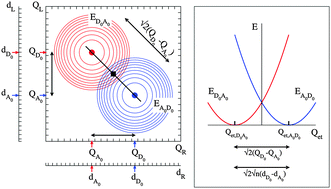Configuration coordinate energy level diagrams of intervalence and metal-to-metal charge transfer states of dopant pairs in solids
Abstract
Configuration coordinate diagrams, which are normally used in a qualitative manner for the energy levels of active centers in phosphors, are quantitatively obtained here for intervalence charge transfer (IVCT) states of mixed valence pairs and metal-to-metal charge transfer (MMCT) states of heteronuclear pairs, in solid hosts. The procedure relies on vibrational frequencies and excitation energies of single-ion active centers, and on differences between ion–ligand distances of the donor and the acceptor, which are attainable empirically or through ab initio calculations. The configuration coordinate diagrams of the Yb2+/Yb3+ mixed-valence pair in Yb-doped YAG and the Ce3+/Yb3+ heteronuclear pair in Ce,Yb-codoped YAG, are obtained and described. They are drawn from empirical data of the single-ions and their usefulness is discussed. The first diagram suggests that IVCT states of Yb2+/Yb3+ pairs may play an important role in the quenching of the Yb3+ emission and it provides the details of the quenching mechanism. The second diagram supports the interpretation recently given for the energy transfer from Ce3+ to Yb3+ in Ce,Yb-codoped YAG via a MMCT Ce4+–Yb2+ state and it provides the details. The analyses of the two diagrams suggest the formation of Yb2+/Yb3+ pairs after the Ce3+-to-Yb3+ MMCT, which is responsible for the temperature quenching of the Yb3+ emission excited via Ce3+ (4f → 5d) absorption in Ce,Yb-codoped YAG.


 Please wait while we load your content...
Please wait while we load your content...